Welcome to life in the slow lane and my first toile for Mr O’s #Blazerof2016. As anticipated in my last update, the instructions were indeed minimal, which is ok if you’ve done this kind of thing before but I haven’t! When I look at the finished toile I’m wondering what I found so difficult – time is a healer I guess!
It was wholly necessary to make a toile. I already knew the largest size of the pattern wouldn’t be big enough but there was a method in my madness. I wanted to test the construction more than anything and didn’t want to waste time making any preliminary changes to the pattern. Now that it’s made and the process understood I can see exactly what I need to do. I can also see some issues that will need further investigation.
First thing I will need to do is to grade it up a whole size. I will use the traditional cut and spread method. The sleeves need some extra room at the bicep (That news was met with a wry smile!) and I may also need to lengthen the sleeves but that will be confirmed once the 2nd toile is made and the shoulder pads are factored in.
The thing that surprised me most about this design was the lining. Fundamentally, there isn’t much of one but it is a summer blazer so it can be forgiven for half measures! there is a kind of butterfly section that overlaps on the inside back, joining the front facings around the armholes, if that makes sense.

A fine excuse to choose some fun lining fabric I think. The sleeves will be fully lined and the remaining exposed seams finished with binding. Might be nice to make some custom binding to match the butterfly lining. I’m not sure that’s what it’s technically called by the way!
I was a bit concerned about the sleeve caps. There seemed to be more gathering and less ease involved here. Then I read Male Devon Sewing’s post on setting in sleeves where he advises to steam-shrink the eased area of the sleeve caps before sewing in. That will help on the real deal, I’m sure. I’ll see what happens 2nd time round before I properly address this but I may also need to start and finish the ease stitches slightly further apart.
The assembly of the collar and collar stand properly had me confused. I really couldn’t make sense of sewing two concave seams together. But it makes sense now that it adds the roundy shape. The black stitching is where the pressed open joining seam will be topstitched.
The topstitching wont be seen in any case once the collar is folded down. Thinking I should use some red melton or similar for the collar stand. It seems to be a feature on some of Mr O’s other jackets. That wont be seen much of either of course. But the joy of knowing it is under there excites me a little bit already!
The one construction instruction that still didn’t translate was attaching the collar to the lapel. The instructions said to sew all round the edge of the collar to a point, trim and turn right side out. It allows nothing to sink into the top of the lapel seam so unless I find instructions somewhere else, I’m going to stop the stitching further back so I can insert the whole 1.5cm seam allowance of the collar, snuggly in place. You can see in the picture below where I’ve unpicked the stitches already to see if that would work.
Burda gives no clue as to how I line the vents on the sleeve cuffs but luckily I read up about ‘fake’ vents on sleeves and so there’ll be no unnecessary fiddlesome lining going on here, hooray!
I’ve enjoyed the process of making a toile, especially getting to write notes all over it so I know what to change and what to remember next time. And I’ve learned so much already, before I’ve even started on the real thing!
So now I’m all set to do some cutting and spreading and will be back with a 2nd toile soon.
While you’re waiting for me, do hop over to see some of Male Devon Sewing‘s amazingly detailed posts for #Blazerof2016. They really are very helpful.






